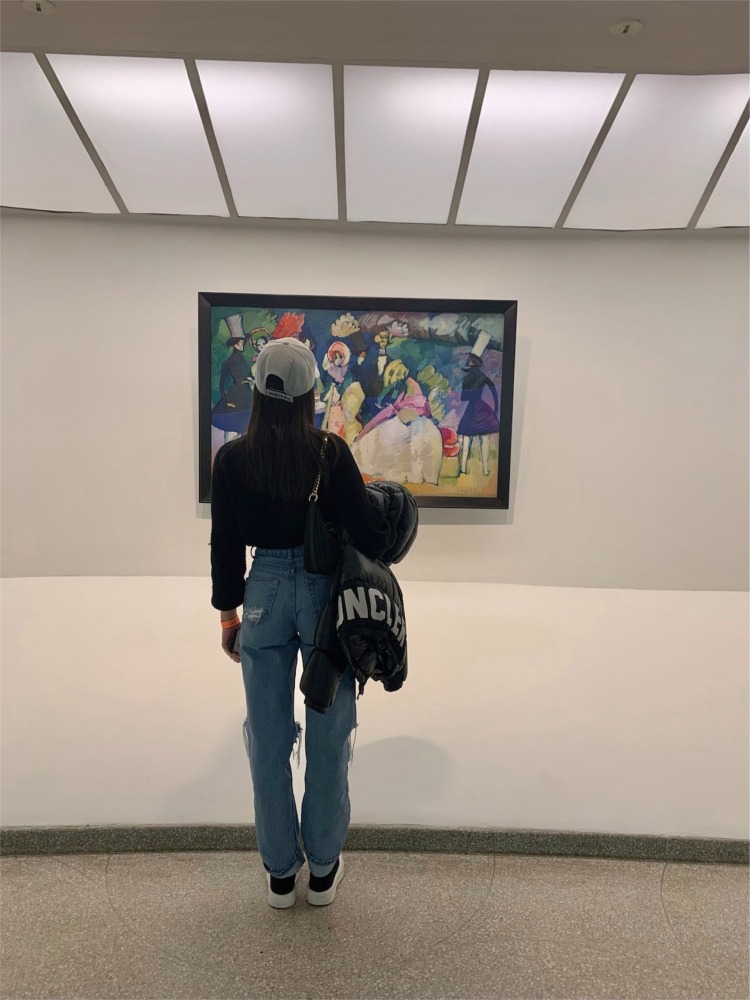Group in Crinolines
at the Guggenheim Museum
Home > New York State Photographs > New York > Group in Crinolines at the Guggenheim Museum

Kandinsky's "Group in Crinolines" hung on the wall of the gallery like a symphony, a riot of shapes and colors that emanated an understated yet powerful energy. As viewers moved closer, the painting seemed to invite them in, its vibrant splashes of paint and intricate patterns mesmerizing them.
The painting featured figures in Russian dress of the mid-nineteenth century, but these figures were stylized and vaguely defined, their outlines blurred and softened by the tumultuous brushstrokes. Nonetheless, there was a sense of movement and emotion, even a hint of spirituality, that captivated viewers. Kandinsky masterfully combined abstraction and representation to express the connection between the physical world and the spiritual one.
While Kandinsky's earlier works had been heavily influenced by Impressionism and Post-Impressionism, "Group in Crinolines" marked a clear step toward abstraction. He had found a way to communicate meaning through color and form, and the audience was awe-struck. It was a momentous moment in Kandinsky's career and one that signaled the dawn of a new era in art.
Group in Crinolines
Wassily Kandinsky was a prominent Russian abstract artist known for his innovative and influential work in the development of abstract art. He is often associated with the abstract movement known as "Der Blaue Reiter" (The Blue Rider), which sought to explore the spiritual and emotional potential of art through abstraction.
One of Kandinsky's notable works is the painting titled "Group in Crinolines" (1909). In this painting, Kandinsky ventures into abstraction while still retaining elements of representation. Here's an explanation of "Group in Crinolines":
Style and Composition
"Group in Crinolines" is a semi-abstract artwork. It depicts a group of figures the women wearing crinolines, a stiff or structured petticoat designed to hold out a skirt, used since the mid-19th century.
Kandinsky's approach to the subject is highly stylized. The figures are rendered in abstract and geometric shapes, and the colors are bold and vibrant, typical of Kandinsky's work during this period.
Abstraction and Symbolism
While the subject matter is still somewhat recognizable (figures in dresses and tail coats), Kandinsky's treatment of the subject pushes toward abstraction. He simplifies and distorts the figures, reducing them to their essential forms.
Kandinsky believed in the spiritual and emotional power of colors and shapes. In "Group in Crinolines," the use of vivid colors and abstract shapes is intended to evoke emotional and spiritual responses in the viewer rather than a literal representation of the scene.
The painting can be seen as a precursor to Kandinsky's later fully abstract works, where he moved away from recognizable subject matter entirely.
Influence and Significance
"Group in Crinolines" is a pivotal work in Kandinsky's artistic development. It marks the transition from his earlier figurative work to his later abstract masterpieces.
It reflects Kandinsky's interest in the synthesis of music and painting, where he sought to express the emotional and spiritual through abstraction, much like how music can convey emotions without relying on recognizable forms.
Kandinsky's exploration of color, form, and abstraction in this painting contributed to the broader development of abstract art in the early 20th century.
In summary, "Group in Crinolines" by Wassily Kandinsky represents a pivotal moment in the artist's career and in the evolution of abstract art. While it retains some elements of representation, it demonstrates Kandinsky's growing fascination with abstraction and his belief in the power of color and form to convey emotions and spirituality in art.


